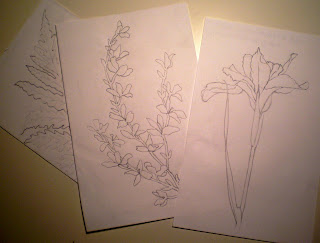I have finished cutting the printing plate I talked about last week and have printed "Iris and Forsythia". It's always exciting to see what that first print will look like because despite lots of planning, it's always a bit of a surprise....
Partially cut soft cut printing plate
In order to print, I gather up my materials and head to the kitchen to be near the sink and to use the counter to spread out my work.
Inking the printing plate
I roll out the black Speedball water soluble block printing ink with a 4 inch wide soft brayer, making sure that there is an even coat on the whole surface of the linoleum. It's easy to see where the ink is because it is shiny and black. Some of the cut areas pick up ink too and I like the value and textures the lines create. I have to be careful NOT to get any blobs of ink on the brayer or they will fill in the incised areas on the plate.
The inked plate with tape for centering the print on the paper
Next, I move the printing plate over to where I have measured out rough masking tape guidelines for the printing plate and paper so that the prints will be consistently centered. In this case, I don't have to worry about being too careful. If I were using a multiple number of plates or doing a reduction print where I would print the same plate several times, I would have to construct a more elaborate registration box.
Rubbing the print
When the paper is centered on the plate, I use a wooden spoon to carefully rub the back of the paper to make sure all areas of the plate have printed. Here, you can just make out the ink beginning to soak into the paper. I usually peek underneath to make sure it looks good before I pull the print off the plate.

"Iris and Forsythia"
9" x 12" • linoleum print
And here it is, the first finished print, called the "Artist Proof". It is meant to be a test print and if I am pleased with it and it needs no more cutting, it becomes the standard for the edition. I want each of the prints to be as exactly the same as possible and I might discard any that do not meet this standard. But, in this case, I'm pretty pleased. I do think that if I had treated both ferns as I did the one on the right, the print would be more balanced in terms of black areas. When I add color this print after it is dry I will be able to compensate for this if I choose to do so.
I pulled 13 prints today and after printing 6 of them I had to take time out to wash and dry the plate since it had gotten pretty scummy. I intend to print some more later. The prints need to dry completely and that can take several days in humid weather. Then, when there's no chance of smudging, I will have the fun of hand coloring one using colored pencils....












